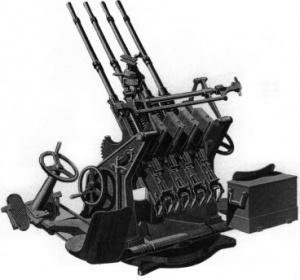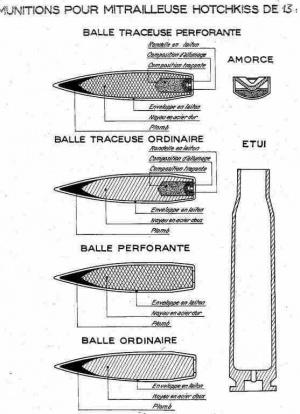Hotchkiss Mle 1930 (13.2 mm)
Contents
Description
The 13.2 mm Hotchkiss Mle 1930 is a French-built heavy machine gun for multi-purpose use. Starting as the Hotchkiss Mle 1929, the Mle 1930 is a ground-based anti-aircraft designation of the machine gun. It is commonly used as close anti-air defence by the French Navy and also by the Army during the '30s until WW2. The guns was also adapted as main armament for tanks, armoured cars and anti-aircraft vehicles. The Hotchkiss was for France the equivalent of the M2 Browning heavy machine gun.
Vehicles equipped with this weapon
General info
The 13.2 mm Hotchkiss offers balanced performance against aircraft and soft targets, but has difficulty against vehicles with more than 20 mm of armour. It is fed by a 30-round magazine, which leads to the weapon's limited capacity to sustain suppressing fire. The gun has a fire-rate of 450 rounds per minute, but in practice it would seldom reach 200 rounds per minute due to the reload and recoil.
Available ammunition
Only one belt is currently available for the Hotchkiss in the game, the AP-T belt.
- AP-T: AP · AP-T
| Penetration statistics | |||||||
|---|---|---|---|---|---|---|---|
| Ammunition | Penetration @ 0° Angle of Attack (mm) | ||||||
| 10 m | 100 m | 500 m | 1,000 m | 1,500 m | 2,000 m | ||
| AP | 28 | 25 | 16 | 10 | 6 | 3 | |
| AP-T | 28 | 25 | 16 | 10 | 6 | 3 | |
| Shell details | ||||||||||||
|---|---|---|---|---|---|---|---|---|---|---|---|---|
| Ammunition | Velocity (m/s) |
Projectile mass (kg) |
Fuse delay | Fuse sensitivity (mm) |
Explosive mass (TNT equivalent) (g) |
Ricochet | ||||||
| 0% | 50% | 100% | ||||||||||
| AP | 800 | 0.05 | - | - | - | 47° | 56° | 65° | ||||
| AP-T | 800 | 0.05 | - | - | - | 47° | 56° | 65° | ||||
Comparison with analogues
- M2HB (12.7 mm) - Similar gun in performance, but a lot more successful. It replaced the Hotchkiss 13.2 mm after WW2 for standardization purpose.
- Type 93 (13.2 mm) - Japanese licensed copy of the Hotchkiss
- Breda Model 31 (13.2 mm) - Italian licensed copy of the Hotchkiss
Usage in battles
This armament has a relatively small calibre which causes the post-penetration damage to be rather low. In many cases, even a direct hit to the crew might not be enough to knock them out. However, the 30-round magazine and fast fire-rate allow the user to place multiple hits in quick succession. Due to the low penetration, even reserve-level armoured vehicles might prove difficult targets. Anything with more than 20 mm of armour is better to avoid in combat. If you get close enough to a ground target, you might find this armament rather effective, but it is still strongly suggested to try to get your enemy from the side and rear where they are more vulnerable and pay less attention.
If you have enough elevation and a traverse speed to follow an air target, this gun can prove pretty effective against aircraft. A couple of hits and the target is likely to be either set afire or lose some critical components.
Pros and cons
Pros:
- Good fire-rate
- Effective against soft targets
- Effective against aircraft
Cons:
- Penetration a bit lacking
- Magazine has only 30 rounds
History
Developed by Hotchkiss & Cie in the mid 1920s, the Hotckiss Mle 1929 was a multi-purpose heavy machine gun. First used by the French Navy, it served as close anti-air defence for ships with a range of up to 2,500 metres. The Army also adopted the gun, but in the Mle 1930 variants. The difference was that the Mle 1930 wasn't equipped with the sight and mount that allow the machine gun to be used against aircraft, as the French Army worried that the bullets might fall back on civilian areas and potentially kill someone. The Army strictly used this armament as anti-tank and anti-infantry weapons in their service.
In the 1930s, the French cavalry mounted the 13.2 mm machine gun onto AMR.35 ZT1 reconnaissance vehicles to add some anti-tank capability to defend themselves during missions. This was also attempted on armoured cars such as the Laffly 80AM. Some machine guns were also presented for export, arming anti-aircraft trucks, though the export attempt as anti-aircraft had no success. As an independent heavy machine gun however, this armament was very successful, been exported notably to Brazil, Poland, and Romania, but also licensed to Italy and Japan, nearly all of which used the 13.2 mm intensively during WW2.
| Penetration statistics | |||||||
|---|---|---|---|---|---|---|---|
| Ammunition | Type of warhead |
Penetration @ 0° Angle of Attack (mm) | |||||
| 10 m | 100 m | 500 m | 1,000 m | 1,500 m | 2,000 m | ||
| Type O | AP | 24 | 23 | 14 | 10 | 7 | 4 |
| Type OT | AP-T | 24 | 23 | 14 | 10 | 7 | 4 |
| Type P | APC | 28 | 27 | 20 | 15 | 11 | 9 |
| Type PT | APC-T | 28 | 27 | 20 | 15 | 11 | 9 |
| Shell details | |||||||||
|---|---|---|---|---|---|---|---|---|---|
| Ammunition | Type of warhead |
Velocity (m/s) |
Projectile mass (kg) |
Fuse delay (m) |
Fuse sensitivity (mm) |
Explosive mass (TNT equivalent) (g) |
Ricochet | ||
| 0% | 50% | 100% | |||||||
| Type O | AP | 810 | 0.051 | N/A | N/A | N/A | 66° | 70° | 72° |
| Type OT | AP-T | 810 | 0.051 | N/A | N/A | N/A | 66° | 70° | 72° |
| Type P | APC | 810 | 0.052 | N/A | N/A | N/A | 66° | 70° | 72° |
| Type PT | APC-T | 810 | 0.052 | N/A | N/A | N/A | 66° | 70° | 72° |
- Cartouche à balle ordinaire O (AP type O)
The Type O was a standard armour-piercing round used against soft targets such as infantry, unarmoured vehicles, and aircraft. The projectile was made of carbon steel and was capped with lead. There was a brass cloak around the projectile.
The round can be identified by the primer seal painted either black or purple.
- Projectile weight: 51.2 g
- Velocity: 810 m/sec
- Cartouche à balle traçante OT (AP-T type OT)
The Type OT was a standard round equipped with a tracer tail. It had the same ballistics as the Type O.
The round can be identified by the primer seal painted green.
- Cartouche à balle perforante P (AP type P)
The Type P round was an armour-piercing hardened round used against armoured targets. The projectile was made of tungsten-steel alloy (3% tungsten, 97% steel) and was tempered. There was a lead cap and brass cloak on the rounds.
The round can be identified by primer seal painted red.
- Projectile weight: 52 g
- Velocity: 810 m/sec
- Cartouche à balle perforante traçante PT (AP-T type PT)
The Type PT was an armour-piercing round equipped with a tracer tail. It had the same ballistics as the Type P.
It can be identified by the primer seal painted yellow.
Media
Excellent additions to the article would be video guides, screenshots from the game, and photos.
See also
- Model 1929 Hotchkiss (13.2 mm) Original single mount version
- Hotchkiss (13.2 mm) German captured version
- Type 93 (13.2 mm) Japanese version built under licence
- Breda Model 31 (13.2 mm) Italian version built under licence
External links
| France anti-aircraft guns | |
|---|---|
| 13.2 mm | Hotchkiss Mle 1930 |
| 20 mm | GIAT M693/mod F2 · Oerlikon KAD (Swiss) |
| 30 mm | HSS 831A |
| 40 mm | Bofors L/60 · Mle. 1951 T1 (Bofors L/70) |





